- 1940s
-
“Those who are enduring the suffering and misery of arthritis cannot find much comfort about the coming of a cure at some time in the future. Pain has a cruel immediacy. And yet it is a tragic fact that scores of thousands live in great pain needlessly.”
—Floyd B. Odlum, first Arthritis Foundation Board Chair, 1948 -
In the BeginningOn May 6, 1948, the Arthritis and Rheumatism Foundation was founded with a goal to attack the challenges of arthritis through a national program to fund medical research and provide better medical services for patients.
- There were few treatment options for arthritis, other than aspirin. Floyd Odlum, an arthritis patient, was recruited by his physician to chair the new organization.
- The first fundraising campaign was chaired by world-renowned entertainer Bob Hope and raised more than $500,000.
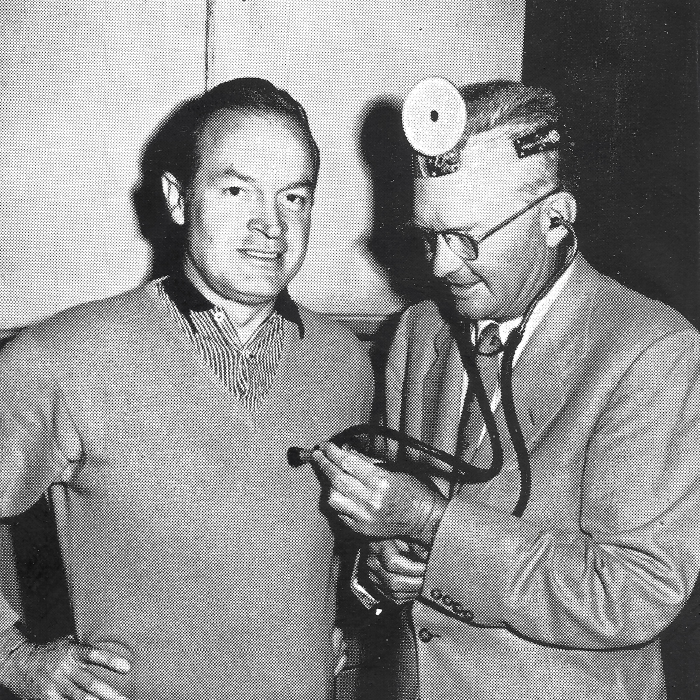
-
Setting the Stage
- We established minimum standard requirements for arthritis clinics, leading to efforts to provide more and better services for people with arthritis.
- We granted funds in 1949 to support the Seventh International Congress on Rheumatic Diseases, pioneering a presentation about cortisone yielding dramatic improvements in rheumatoid arthritis and sparking a surge of new studies that began a decade-long “age of steroids.” Scientists soon learned about the limitations and side effects of cortisone.
- In the coming years, we enabled scientists to also gradually learn that arthritis was not one disease, but that there are more than 100 different forms of arthritis.
- 1950s
-
“Although there is a long way to go, we have come a long way with the help of an interested public. With continued and expanded support, we shall follow through to the fulfillment of the aims to which this organization is dedicated.”
—General George C. Kenney, Arthritis Foundation President, 1955
-
10 Years of ProgressOne of our mobile physical therapy units visits homebound arthritis patients
We prompted Congress to establish the National Institute of Arthritis and Metabolic Diseases, marking the beginning of federal government support for arthritis research.
- Arthritis Foundation research suggested that rheumatoid arthritis was an autoimmune disease.
- We put new emphasis on communication programs aimed at the general public, including a special awards program to recognize excellence by the news media in reporting about arthritis.
- We began preliminary work on developing methods for clinical trials of drugs, while research pressed forward in several disciplines, from immunology to biochemistry.
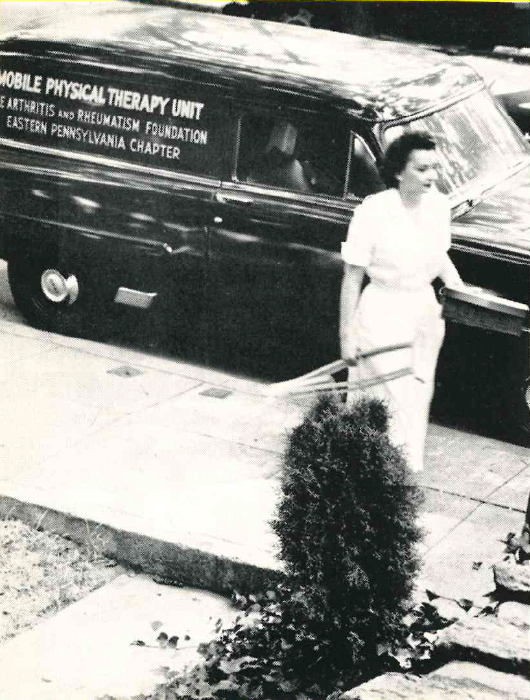
-
Forging AheadDruggists informed patients about the help and support available from the Arthritis Foundation
- In 1951, the Arthritis Foundation’s first national postdoctoral research fellowships were awarded — seven grants totaling $33,500.
- In 1954-55, we funded special training in arthritis for more than 25,000 physicians and 5,000 nurses, giving them a better understanding of the disease in its many forms.
- Local Arthritis Foundation chapters were formed nationwide, supporting 200 treatment centers and dozens of “traveling clinics” for those bedridden at home.
- We supported a drive to enable skilled physical therapists to make 77,000 visits to homebound patients and mobilize rehabilitation programs to help get disabled workers back to work.
- We released the first issue of the journal Arthritis and Rheumatism, published in 1958.
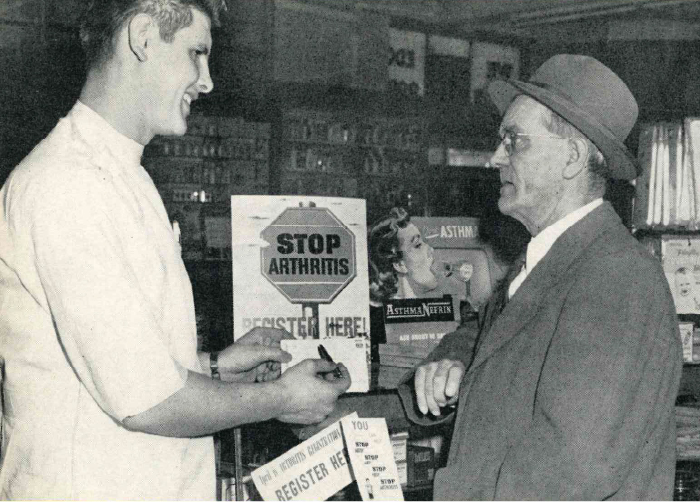
- 1960s
-
President Johnson meeting an arthritis patient and his child at a 1964 ceremony
“Surely no more vexing health problem can be named than the one that you battle, arthritis. Like most of our problems, it is within our power to solve it. If we have the will, we’ll find the way.”
—Lyndon B. Johnson, President of the United States, speaking at the Arthritis Foundation’s 20th anniversary dinner in New York City, 1968
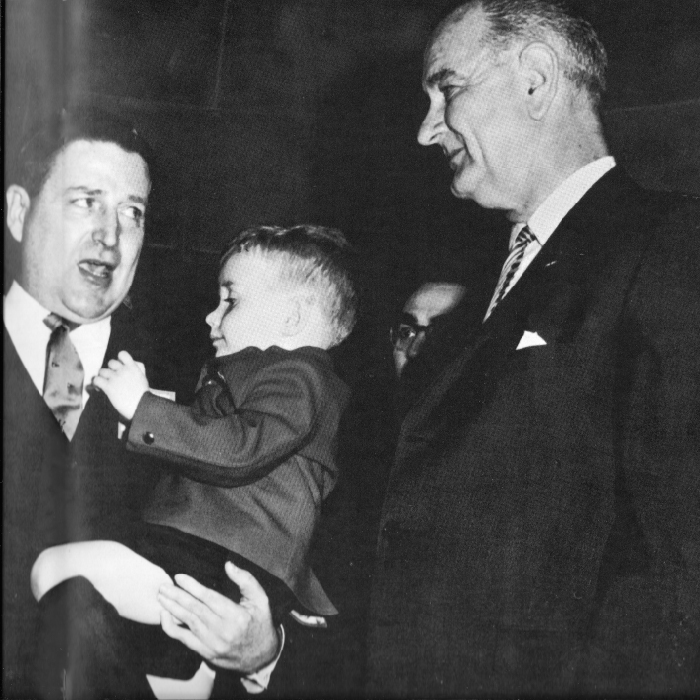
-
20 Years of ProgressWalt Disney was among numerous celebrities supporting the Arthritis Foundation
This decade, our educational programs expanded, and many famous people got on board to support our cause — Lucille Ball, Jimmy Stewart, Bing Crosby, Carol Burnett, Julie Andrews, Walt Disney and more.
- In 1964, our name was shortened from the Arthritis and Rheumatism Foundation to the Arthritis Foundation.
- At our urging, doctors, nurses, physical therapists and other health professionals began sharing the latest technical knowledge with each other, and we advocated for increased federal funding for arthritis research.
- We persuaded the Office of the Surgeon General to hold a special workshop on “Prevention of Disability From Arthritis” in 1965, focusing on how we could make community health services more responsive to the needs of people with arthritis.
- In 1968, as the national mood shifted to social issues, we spotlighted the “Silent 16 Million” Americans with arthritis, many of whom were poor, marginalized and unable to lead productive lives.
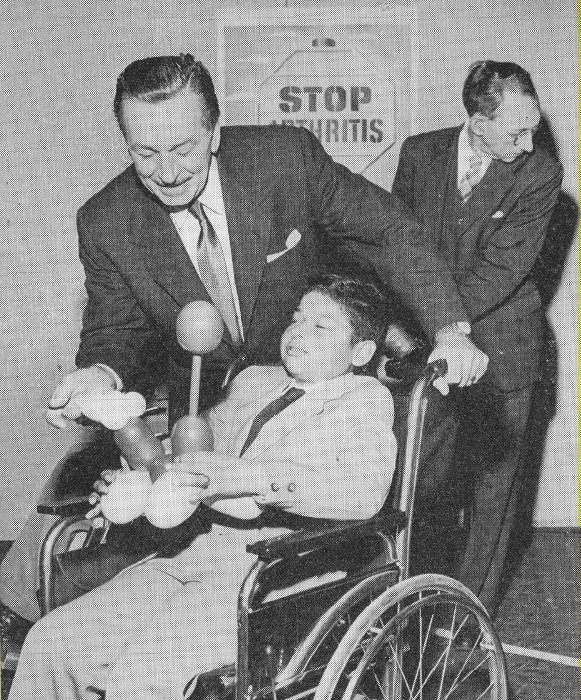
-
Spreading the Word
- In 1964, in partnership with the American Pharmaceutical Association, we distributed 350,000 pieces of literature about arthritis to drugstores in 360 communities nationwide.
- That same year, an article appeared in the widely read national publication Parents’ Magazine, giving the basic facts on arthritis and what to do, written by the Arthritis Foundation’s consulting medical director.
- We published and distributed “Osteoarthritis — A Handbook for Patients” in 1967.
- By the Arthritis Foundation’s 20th anniversary, scientific research we funded had contributed to the development of numerous new drugs and improved treatment methods, helping prevent disability and often restoring lost function.
- 1970s
-
“Our goal should be to help the arthritis patient maintain maximum independence for as long as possible and to rehabilitate this person to the fullest extent possible. It is heartening for me to realize that so many additional thousands of people with arthritis are now receiving this much needed help and comfort.”
—W.W. Satterfield, Arthritis Foundation Board Chair, 1978
-
30 Years of ProgressBetty White and Allen Ludden participating in an Arthritis Foundation telethon
By the end of the 1970s, when the number of Americans estimated to have arthritis had nearly doubled, from 16 million to 31 million, we supported rapid advances in research on human cells.
- By then, almost 400 scientists had been trained through Arthritis Foundation-funded fellowships, resulting in an arsenal of new drugs being developed.
- Joint replacement surgery, with our scientific guidance, was saving thousands of patients from lifelong immobility.
- At our urging, the National Arthritis Act was passed by Congress, earmarking funds for developing arthritis care centers, medical school assistance and long-range plans to address arthritis.
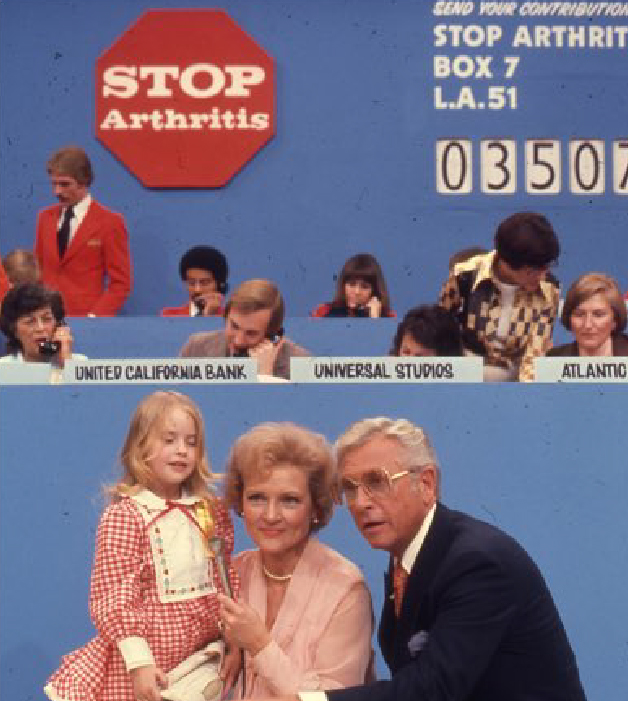
-
Gaining MomentumAn Arthritis Foundation ad to raise awareness that kids get arthritis, too
- Arthritis Foundation telethons continued to draw more donors, raising funds for research and resources, thanks to the participation of even more celebrities supporting our cause, including Milton Berle, Betty White, Allen Ludden, Mary Tyler Moore, Ed Asner, Doc Severinsen, Ed McMahon, George Burns, Paul Lynde and many more.
- At our insistence, Congress and U.S. President Richard M. Nixon designated May as “National Arthritis Month” in 1972, as a special time to emphasize research, service and education, and to raise funds, which has continued every May since.
- In 1978, we funded research into arthritis as a symptom of Lyme disease, leading to recognition that Lyme is an infectious disease caused by a tick bite.
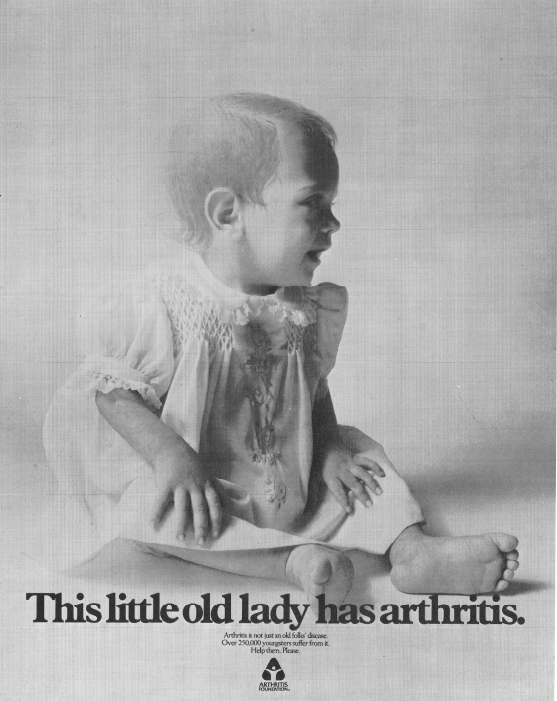
- 1980s
-
“The Arthritis Foundation is people helping each other fight a mean disease. Our strength is concerned people with a strong commitment to succeed. Through research, education and patient services, we’re on a scoring drive.”
—“Mean” Joe Green, former National Football League player (1969-1981) and Arthritis Foundation General Chairman, 1981
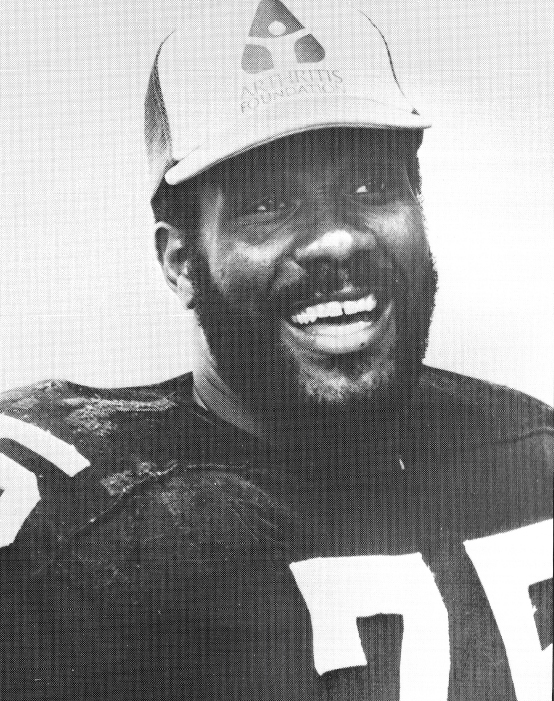
-
40 Years of ProgressThe Arthritis Today magazine began in 1987, putting reliable information into the hands of consumers
This decade, we further strengthened our commitment to research and secured more private and federal funds for arthritis projects through our continued telethons and other marketing efforts.
- We introduced the Arthritis Self-Help Course and made a variety of land and water exercises and other educational materials available nationwide.
- The national Jingle Bell Run came to life in 1984 to raise money for arthritis research and resources.
- We launched Arthritis Today magazine in 1987, putting reliable information into the hands of consumers through grocery stores, newsstands and subscriptions.
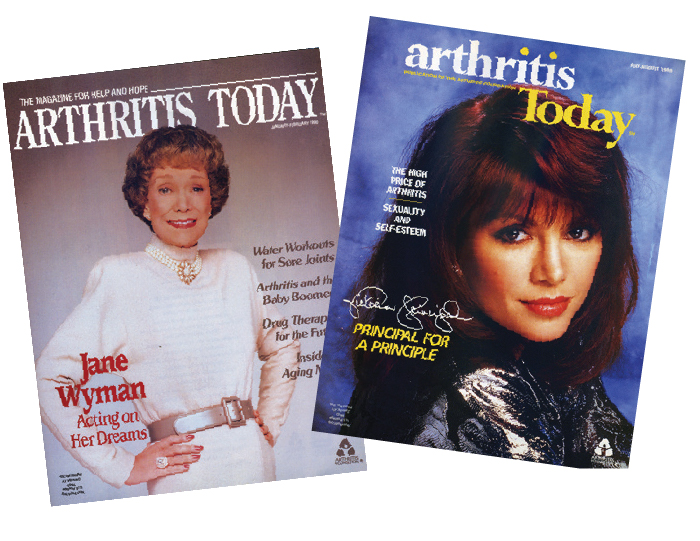
-
Groundbreaking Discoveries
- We funded a study in 1982 that led to methotrexate becoming a mainstay of treatment for rheumatoid arthritis.
- In 1983, we funded a research grant to explore the role of interleukin-1 in rheumatoid arthritis, ushering in the biologic era — and fundamental to modern treatments.
- We kicked off our first National Juvenile Arthritis Conference (now JA Family Summit) in 1984, bringing together children with JA and their families to learn, exchange tips, make new friends and have fun.
- We initiated our Ease of Use product testing and development program in 1988, encouraging manufacturers to design user-friendly products geared specifically toward the needs of people living with arthritis.
- 1990s
-
“Society, the government, industry and managed care are awakening to the increased burden — human and economic — of arthritis. Statistics now reveal arthritis as a national public health problem and the leading cause of disability in the United States.”
—Don L. Riggin, Arthritis Foundation President and CEO, 1998
-
50 Years of ProgressThe Arthritis Foundation and the CDC worked together to get people moving to relieve arthritis pain
This decade, we worked with the Centers for Disease Control and Prevention (CDC) to launch a national arthritis action plan.
- We made headway in efforts that led to developing the first biologic medications, changing the arthritis treatment landscape.
- Gradually, largely due to our research efforts over the years, wheelchairs weren’t needed as much as before, and better quality of life became possible.
- Through our nationwide “Heroes Overcoming Arthritis” campaign, we shared the stories of women and men of all ages meeting the daily challenges of arthritis in their own special way.
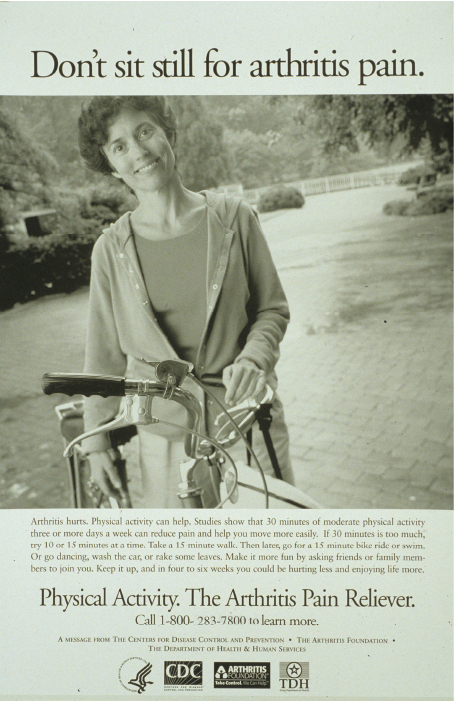
-
Moving ForwardEarly arthritis.org homescreen
- We launched our website — arthritis.org — in1995, including collaborations with other websites like MSNBC.com and a national chat on ABCNews.com.
- We supported research leading to the development of etanercept (Enbrel), introduced in 1998 — the first biologic medication approved to treat autoimmune arthritis.
- That same year, we also co-sponsored North American Rheumatoid Arthritis Consortium (NARAC) research and maintenance of a database on genetic susceptibility to rheumatoid arthritis, funded by the Arthritis Foundation and two National Institutes of Health organizations.
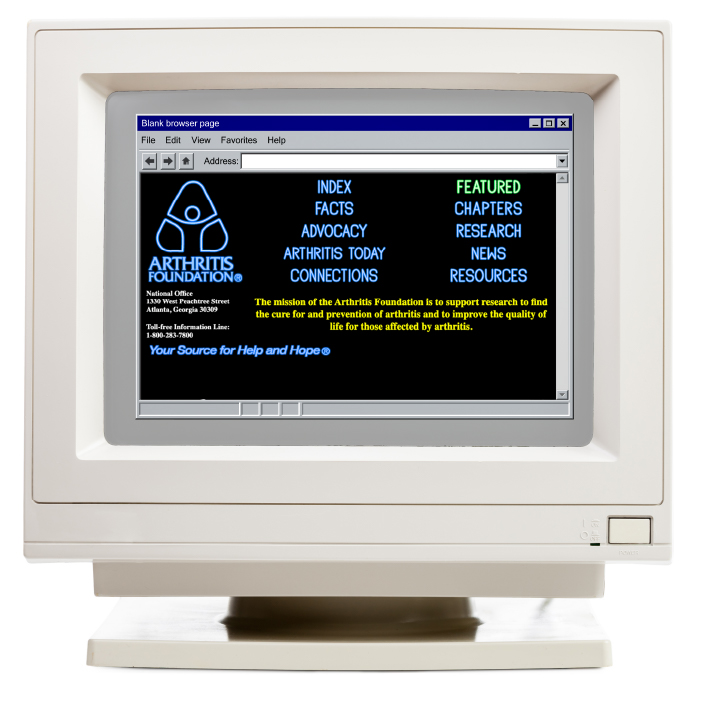
- 2000s
-
“Our willingness to come together is our strength, and our ability to move toward a common goal is our power. Together, we achieve what we once thought was impossible. Together, we move beyond today to a world free of arthritis pain.”
—John H. Klippel, MD, Arthritis Foundation President and CEO, 2009
-
60 Years of ProgressA National Public Health Agenda for Osteoarthritis” publication which stemmed from collaboration between the Arthritis Foundation and the CDC
This decade, we continued making major investments in research, education and advocacy, as well as developed screening tools to facilitate early diagnosis and treatment, while providing guidance for patient self-management.
- In 2001, we launched the California Coast Classic fundraiser, a 525-mile biking trek from San Francisco to Los Angeles, along the scenic Pacific Coast Highway — which has raised millions of dollars annually for our life-changing work ever since.
- We launched the Arthritis Walk (now Walk to Cure Arthritis) national fundraiser in 2001 as one of our major signature events, raising crucial funds for arthritis research and resources.
- We partnered with the Ad Council on the “Moving Is the Best Medicine” public service campaign to promote physical activity.
- A yearlong collaborative effort led by the Arthritis Foundation and the Centers for Disease Control and Prevention (CDC) — to explore the public health and socioeconomic impact of osteoarthritis — culminated in an Osteoarthritis Summit in 2009, which yielded the “National Public Health Agenda for Osteoarthritis” publication.
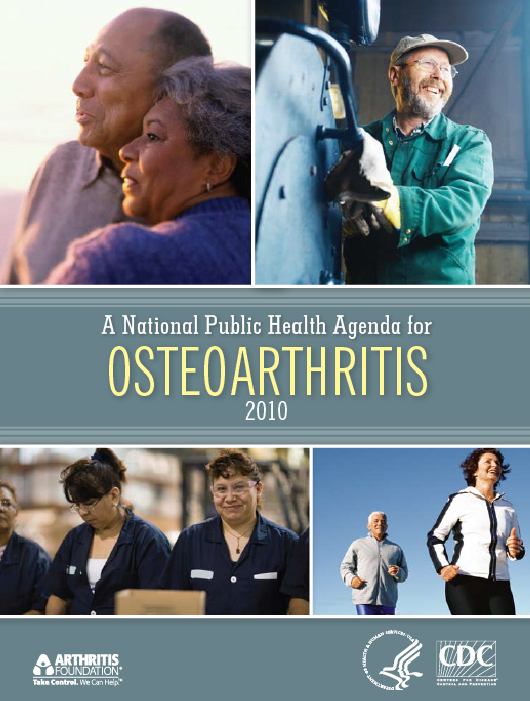
-
Touching More Lives
- We supported the discovery of the FDA-approved biologic anakinra (Kineret) in 2000, to treat rheumatoid arthritis — a modified version of interleukin-1 that inhibits immune responses.
- We were a key player in passing the federal Children’s Health Act of 2000, which intensified research into juvenile arthritis and began closing the gap in the pediatric rheumatology shortage. A congressional statement said: “This act will have a far-reaching impact on the health of America’s youth, addressing juvenile arthritis (JA) and other childhood diseases.”
- In 2002, we teamed up with the Childhood Arthritis and Rheumatology Research Alliance (CARRA) to strengthen our partnership to benefit thousands of kids living with JA and related conditions.
- We demonstrated that it made sense to provide coverage for self-administered therapies, leading to the Medicare Modernization Act of 2003, benefiting 50,000 Medicare beneficiaries with rheumatoid arthritis and other rheumatic diseases.
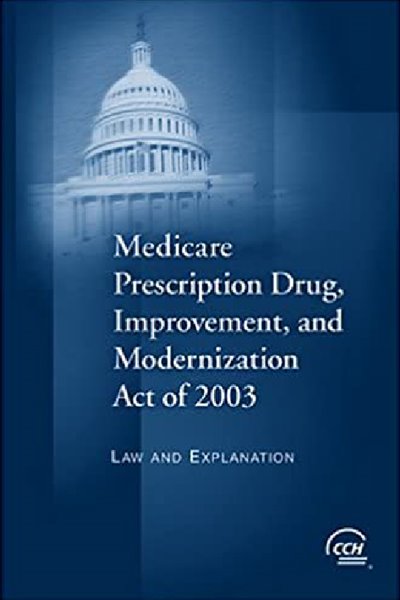
- 2010s
-
“Arthritis is serious. It is debilitating. It is painful. That’s why the Arthritis Foundation exists. We do all of this because the nation’s leading cause of disability should not be considered inevitable and acceptable.”
—David E. Shuey, Arthritis Foundation Board Chair, and John H. Klippel, MD, Arthritis Foundation President and CEO, 2010
-
70 Years of Progress2016 report on arthritis and the U.S. military and veterans
This decade, we focused on fine-tuning our research strategy, increasing access to health care and bolstering our many life-changing programs and services. We also continued our work to bring new medications to market faster.
- We zeroed in on our military veterans and servicemen and servicewomen, appealing for more federal funding to research their disproportionate incidence of arthritis and potential solutions.
- We expanded our outreach to more diverse partnerships — through our Ease of Use product certification program, campaigns with retailers and other partners reaching a large number of consumers, and Fundraise Your Way/Do It Yourself opportunities — setting the stage for even more progress to come.
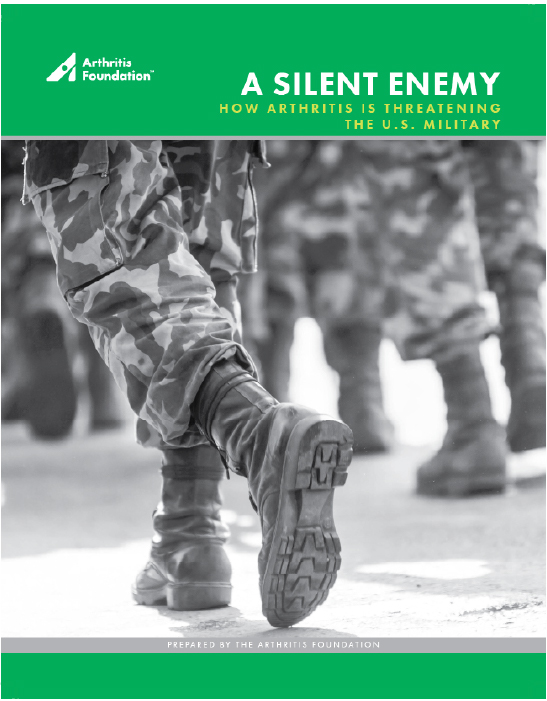
-
Blazing New Trails
- We funded research leading to the invention of the biologic secukinumab (Cosentyx), approved by the FDA in 2015 to treat ankylosing spondylitis and psoriatic arthritis.
- In 2017, we launched scientific initiatives to fund advancement of osteoarthritis treatments, cultivation of a new generation of rheumatologists and conquering childhood arthritis.
- We introduced guidelines in 2019 for the use of CBD (cannabidiol, a plant-based compound) to relieve arthritis pain — the first-ever CBD guidance from a major health organization, garnering widespread media attention.
- We co-wrote model legislation on step therapy reform, which has served as the basis for bills passed in 34 states and counting — and for the Safe Step Act federal bill reintroduced in the current Congress.
-
Putting Patients First
- After the Arthritis Introspective support network merged with the Arthritis Foundation in 2016, we started Live Yes! Connect Groups —to connect people with others who share an interest in a particular arthritis disease type or other common challenges or interests.
- We launched INSIGHTS in 2019, one of the largest patient-reported outcomes studies for adults and parents of children with arthritis, to inform and influence gaps in research and research strategies — covering physical health, emotional and social health and experience of care — the outcome of which led to a wealth of new resources and programming about pain management.
- In 2019, we also launched our ongoing free webinars series on a wide range of topics, as well as our Live Yes! With Arthritis podcast.
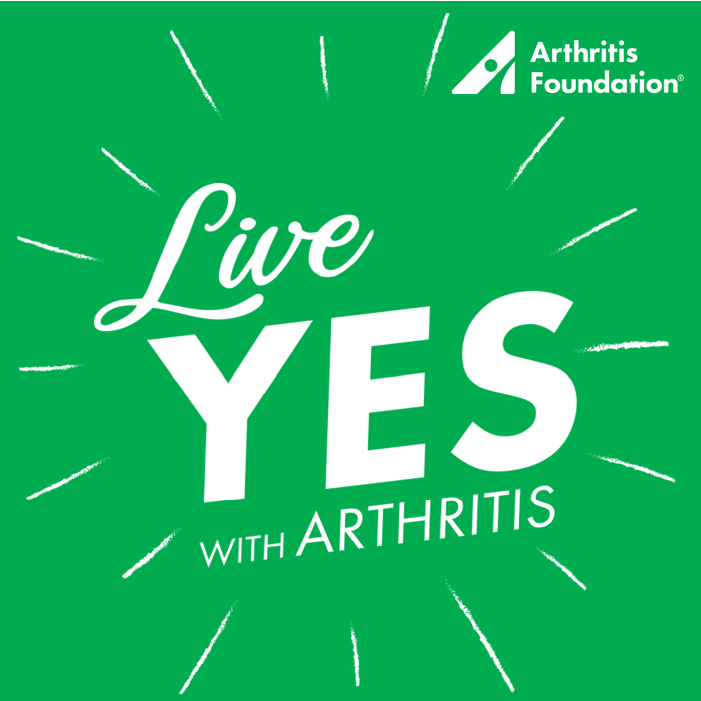
- 2020s
-
Steve Taylor celebrating at an Arthritis Foundation event in Atlanta in 2022."As we commemorate 75 years of groundbreaking history, we reflect on the Arthritis Foundation’s incredible progress while working tirelessly toward an ambitious future. I’m excited about all we’re doing to support people with arthritis today, while paving the way to scientific breakthroughs."
—Steven Taylor, Arthritis Foundation President and CEO, 2023
-
Our work today and beyond focuses on accelerating scientific research; breaking down barriers in health care and fixing inequities; and expanding patient education opportunities. We’re accomplishing all of that and more, as we continue our commitment to help people with arthritis and their loved ones navigate their own unique journeys.
- We’re spearheading deeper osteoarthritis research, including our leadership of the OA Clinical Trial Network, to encourage drug developers to study new therapies for OA.
- We’re also continuing to make progress to advance treatments for rheumatoid arthritis, juvenile arthritis and other forms of this complex, multifaceted disease.
- Our Live Yes! Connect Groups, in person and virtual, have grown to at least 75 groups, bringing people together to share their common interests and challenges with arthritis.
- We expanded our Helpline services in 2021 to respond to requests in Spanish and many other languages and launched our revamped Spanish language website in 2022.
-
Pivoting and AdjustingHow it Hurts Report which explains the annual findings of arthritis pain
- As the global coronavirus pandemic struck in early 2020, we rallied the arthritis community to band together and focus on what was still most needed.
- We made sure patients and their families were kept up to date in a variety of ways on the latest advice, self-care tips and other important COVID information.
- Comedian Matt Iseman teamed up with football icon Rob “The Gronk” Gronkowski and more celebrities to host “Survive and Thrive: Together in Isolation,” an engaging online fundraiser, which, along with a special COVID emergency response Giving Tuesday Now campaign, raised $240,000 for arthritis research and resources.
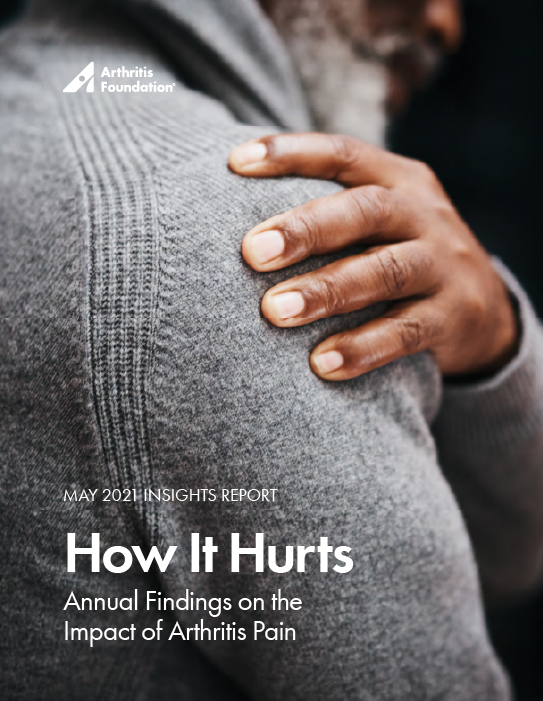
-
Making Great StridesPhoto taken at our 2023 Pathways Conference where we train volunteers and arthritis advocates
- We partnered with the FDA in 2021 to convene osteoarthritis experts and researchers from around the world for a virtual workshop on developing new treatments with long-term benefits for those who battle OA.
- By 2021, each Live Yes! With Arthritis podcast episode was in the top 10% of all downloads during its first week of release.
- Our “How It Hurts” report in 2021 took a deep dive into arthritis pain and underscored why further action is needed, and why we’re taking extra steps to put powerful new tools and resources into the hands of patients.
- In 2022, we issued a statement taking a stance on biosimilar medications that are increasingly becoming available to people with arthritis, in addition to biologics.
- We released our first-ever report of its kind on juvenile arthritis in 2022, based on a collection of data from a survey completed by parents and guardians of children ages 5 to 17.
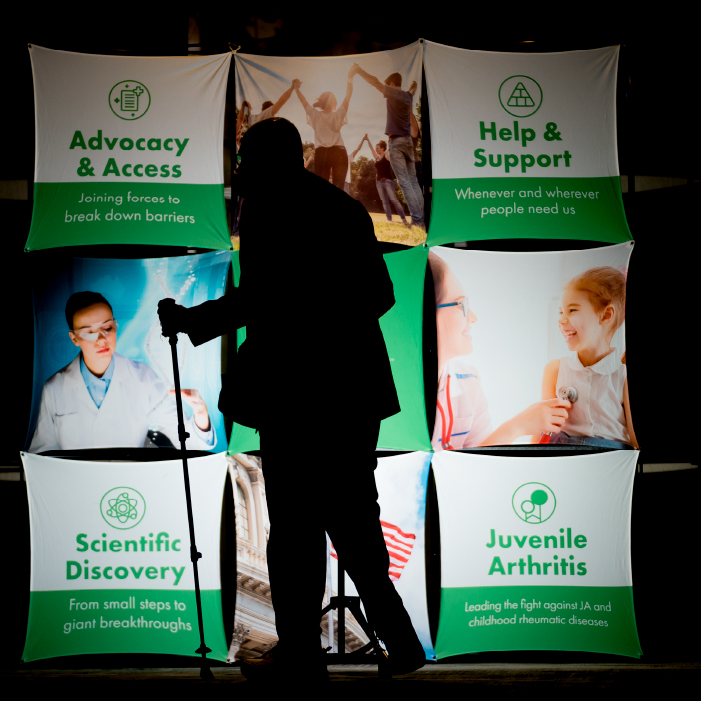
-
Shaping the Future
- At the end of 2020, the No Surprises Act became federal law, thanks in part to the Arthritis Foundation’s nearly two years of advocacy, to make sure patients don’t get surprised by unexpected medical bills.
- We launched our Arthritis@Work program in 2021, offering turnkey tools and resources to help businesses support their 1 in 4 employees living with arthritis.
- We worked with a coalition of patient and provider groups to secure funding in 2022 for the Pediatric Subspecialty Loan Repayment Program, incentivizing pediatric rheumatologists to work in under-served areas to address the critical workforce shortage.
- As part of the Inflation Reduction Act, passed by Congress in 2022, we presented data and stories about the effects of high costs in Medicare Part D, which led to securing a $2,000 cap in out-of-pocket costs.
Together, we are conquering arthritis.
The resources we provide and the progress we make are only possible because of people like you. Your gift will help provide our community greater access to care, support and resources and fund groundbreaking research that brings us closer to a cure. Arthritis is relentless. So are we. Please give today!
